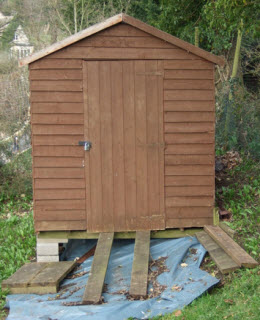Shed ramps - You have a wider choice than you think
The daredevil Evel Knievel had an awesome ramp.
In November 1973 he used the ramp, and his Harley Davidson XR-750, to enable him to jump over 50 cars at the Los Angeles Memorial Coliseum in California.
The record stood for 35 years.
Your shed ramp will be 'slightly' different than Evels' but there is more choice than you might think to help make a smooth transition for getting wheeled equipment in and out of your shed.
What are the main types of shed ramps?
Shed ramps can be made from three main types of material:
- Timber
- Concrete
- Metal
Timber is probably the easiest material to work with
 A very simple plank type shed ramp.
A very simple plank type shed ramp.
Very slippy, bendy and not very permanent.
The simplest of all ramps is probably a couple of wooden planks with one end resting on the ground and the other on the threshold of the shed. The points to make sure of here are that the planks are strong enough and that they are securely fixed. The plank type of ramp has the disadvantage that there is a relatively narrow path for the wheels of what ever equipment you are using to follow. If you deviate from this path the equipment can slip off, so it can be quite a hazard.
To avoid the problems of plank type ramps a full width timber ramp can be used. This is formed from triangles of pressure treated timber that bear directly on to the ground with planks spanning between them.
Both of the timber type ramps have a disadvantage that when wet they can get very slippery. To over come this, a good solution is to fix some galvanised welded wire mesh to the surface using galvanised staples to give some additional grip.
Grip is not such a problem for the concrete ramp.
A concrete ramp is much more permanent than a wooden one
A concrete ramp is also a lot more work to create. To make a concrete ramp you will need to make a timber form to the profile of the ramp that you want to create. The ground beneath the form should be at least 4" (100mm) of compacted stone. Probably the easiest way to get the concrete is to purchase the drymix bags and just add water. The mix should be kept fairly stiff (don't add too much water) as the surface of the ramp that you are casting will be sloping.
In the top surface of the ramp if you make some slanting grooves that run to a central drainage channel then this will help water to drain off the surface and also the ridges will give additional grip for traction getting in and out of the shed.
The concrete ramp is the heaviest of the three materials, the aluminium ramp is the lightest.
Metal ramps made of steel and aluminium are factory made
The factory made ramps are similar to the basic timber plank ramps. However the metal ramps have embossed and punched holes in them to give grip. They also have the edges turned up to help stop wheels going off the side.
The problem with plank type ramps is that they are removable and they can go astray. One way to overcome this is to make a storage area beneath the shed so that when you need to use the ramps you just pull them out and then when you are finished they just slide back into position. This is a great way to combine convenience and function.
Ramps are available in both steel and aluminium. Aluminium ramps are the lightest but they are not as strong and robust as the steel ramps. The steel ramps are heavier but they are stronger and will withstand a lot more abuse than an aluminium ramp. You pay your money and you make your choice.
To summarize
- The timber ramps are probably the easiest to make
- The concrete ramp is hard work but is far and away the strongest
- The metal ramps have very good grip and are light in weight
Evel Knievels ramp was purpose made for high speed
Your ramp should be purpose made for the dimensions and landscaping around your shed.
Timber and concrete ramps are made using materials from your local builders merchant.

Keep in touch with our monthly newsletter
Shed Building Monthly




